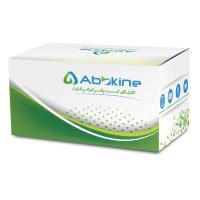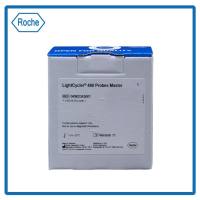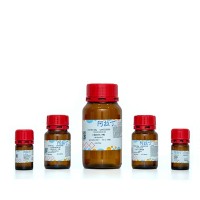Proteolytic Fingerprinting of Complex Biological Samples Using Combinatorial Libraries of Fluorogenic Probes
互联网
- Abstract
- Table of Contents
- Materials
- Figures
- Literature Cited
Abstract
Proteases have garnered interest as candidate biomarkers and therapeutic targets for many human diseases. A key challenge is the identification and characterization of disease?relevant proteases in the complex milieu of biological fluids such as serum, plasma, and bronchoalveolar lavage, in which a multitude of hydrolases act in concert. This unit describes a protocol to map the global proteolytic substrate specificities of complex biological samples using a concise combinatorial library of internally quenched fluorogenic peptide probes (IQFPs). This substrate profiling approach provides a global and quantitative comparison of protease specificities between different biological samples. Such a comparative analysis can lead to the identification of disease?specific ?fingerprints' of proteolytic activities with potential utility in diagnosis and therapy. Curr. Protoc. Protein Sci. 70:21.22.1?21.22.14. © 2012 by John Wiley & Sons, Inc.
Keywords: FRET; global proteolytic specificities; proteases; protease substrate identification
Table of Contents
- Introduction
- Basic Protocol 1: Optimization of Protease Assay Screen with FITC‐Casein
- Alternate Protocol 1: Optimization of Protease Assay Screen with Generic Peptide Probes
- Basic Protocol 2: IQFP Library Screen of Biological Samples
- Basic Protocol 3: Deconvolution of IQFP Peptide Motifs Identified in the Library Screen
- Reagents and Solutions
- Commentary
- Literature Cited
- Figures
- Tables
Materials
Basic Protocol 1: Optimization of Protease Assay Screen with FITC‐Casein
Materials
Alternate Protocol 1: Optimization of Protease Assay Screen with Generic Peptide Probes
Basic Protocol 2: IQFP Library Screen of Biological Samples
Materials
Basic Protocol 3: Deconvolution of IQFP Peptide Motifs Identified in the Library Screen
Materials
|
Figures
-
Figure 21.22.1 Endpoint fluorescence measurement for cleavage of FITC‐casein by Aspergillus fumigatus culture supernatant diluted 1:50 in assay buffers representing each of the four major protease classes. Maximum proteolytic activity was observed in both serine protease buffer (HEPES, pH 8.0) and metalloprotease buffer (Tris, pH 7.4). These experimental results, along with literature indicating that serine proteases are the most abundant class of proteases secreted in AF culture supernatant, led to the selection of HEPES buffer, pH 8.0, for IQFP library screens. View Image -
Figure 21.22.2 Fluorescence fold change values observed for cleavage of the generic IQFP MCA‐RPPGFSAFK (DNP) by human plasma samples collected from the same patient at two different disease‐stage time points. The plasma samples were diluted 1:1 in four assay buffers. Maximum proteolytic activity for both plasma samples was observed in HEPES buffer, pH 8.0, which was then chosen for library screens of the plasma samples. View Image -
Figure 21.22.3 IQFP library screen of pooled complement‐preserved normal human serum at 1:10 dilution. (A ) Heat map generated from fluorescence fold change values calculated at the assay end point ( t 6h ). The heat map corresponds to stacked 96‐well library plates as indicated. Each yellow square corresponds to a library well and the brightness of each square corresponds to calculated fold change value for that well. (B ) Example of IQFP library peptide containing the variable amino acid sequence of ‘AIL.’ (C ) Variable position amino acid distribution profile for library sequences cleaved by human serum. View Image -
Figure 21.22.4 Deconvolution profile for the peptide motif I/L‐F/Y‐F/Y selected from the IQFP library screen of guinea pig BAL. (A ) A representation of a 96‐well assay plate with cleaved wells highlighted in green. The selected peptide motif is written in single‐letter amino acid code. (B ) Guinea pig BAL cleavage profile of the 8 individual constituent peptides from the motif. A fluorescence fold change value of 2 or higher is considered indicative of peptide cleavage (a ‘positive hit’). View Image
Videos
Literature Cited
| Literature Cited | |
| Backes, B.J., Harris, J.L., Leonetti, F., Craik, C.S., and Ellman, J.A. 2000. Synthesis of positional‐scanning libraries of fluorogenic peptide substrates to define the extended substrate specificity of plasmin and thrombin. Nat. Biotechnol. 18:187‐193. | |
| Cravatt, B.F., Simon, B.M., and Yates, J.R. III. 2007. The biological impact of mass spectrometry‐based proteomics. Nature 450:991‐1000. | |
| Cravatt, B.F., Wright, A.T., and Kozarich, J.W. 2008. Activity‐based protein profiling: from enzyme chemistry to proteomic chemistry. Annu. Rev. Biochem. 77:383‐414. | |
| Diamandis, E.P. 2004. Mass spectrometry as a diagnostic and a cancer biomarker discovery tool: Opportunities and potential limitations. Mol. Cell. Proteomics 3:367‐378. | |
| King, J.Y., Ferrara, R., Tabibiazar, R., Spin, J.M., Chen, M.M., Kuchinsky, A., Vailaya, A., Kincaid, R., Tsalenko, A., Deng, D.X., Connolly, A., Zhang, P., Yang, E., Watt, C., Yakhini, Z., Ben‐Dor, A., Adler, A., Bruhn, L., Tsao, P., Quertermous, T., and Ashley, E.A. 2005. Pathway analysis of coronary atherosclerosis. Physiol. Genomics 23:103‐118. | |
| Thomas, D.A., Francis, P., Smith, C., Ratcliffe, S., Ede, N.J., Kay, C., Wayne, G., Marin, S.L., Moore, K., Amour, A., and Hooper, N.M. 2006. A broad spectrum fluorescence based peptide library for the rapid identification of protease substrates. Proteomics 6:2112‐2120. | |
| Watson, D.S., Jambunathan, K., Askew, D.S., Kodukula, K., and Galande, A.K. 2011a. Robust substrate profiling method reveals striking differences in specificities of serum and lung fluid proteases. BioTechniques 51:95‐104. | |
| Watson, D.S., Feng, X., Askew, D.S., Jambunathan, K., Kodukula, K., and Galande, A.K. 2011b. Substrate specificity profiling of the Aspergillus fumigatus proteolytic secretome reveals consensus motifs with predominance of Ile/Leu and Phe/Tyr. PLoS One 6:1‐16. |







